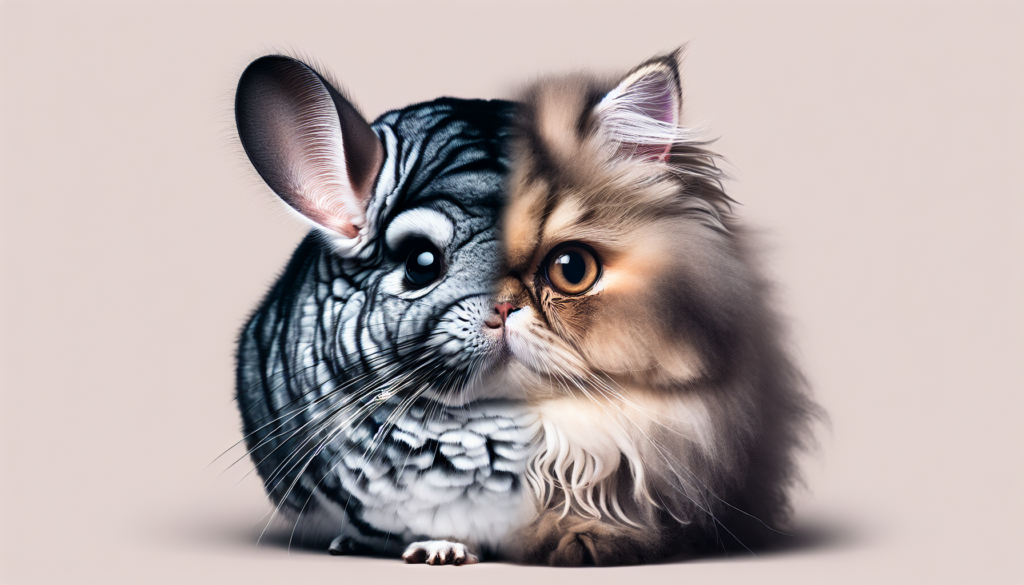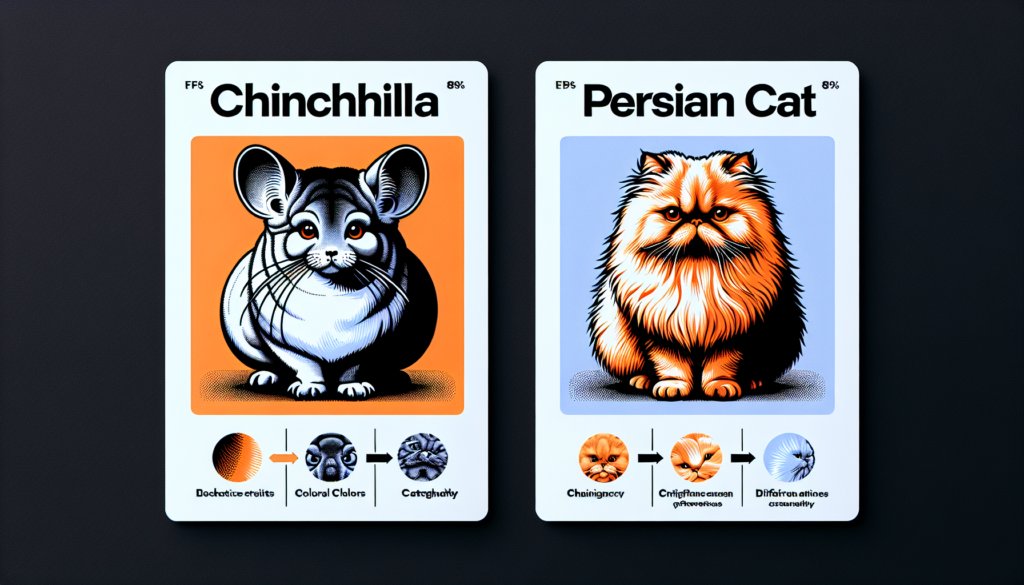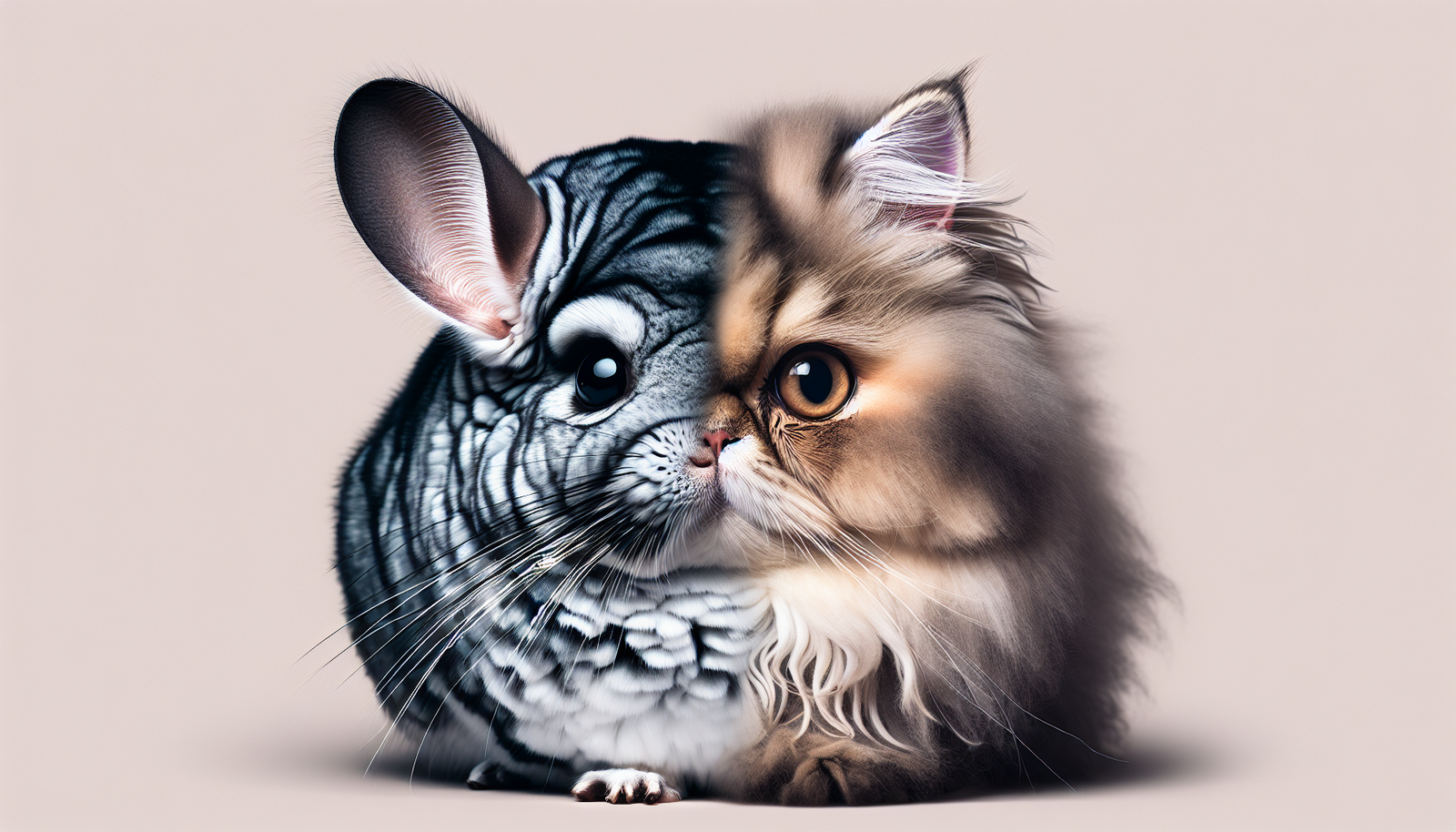If you’ve ever found yourself wondering how to tell the difference between a chinchilla and a Persian cat, you’re not alone. These two adorable creatures may share some similar features, but with a keen eye and a little knowledge, you’ll soon be able to spot the distinguishing characteristics that set them apart. From their fur texture to their facial structure, understanding the subtle nuances will allow you to confidently identify whether you’re in the presence of a playful chinchilla or a majestic Persian cat. So, let’s embark on this delightful journey of feline discovery together, shall we?
Physical Appearance
Coat Length
One major difference between a chinchilla and a Persian cat is their coat length. Chinchillas have a short, dense coat that lies close to their body, while Persian cats have long, luxurious fur that forms a thick coat. Chinchillas may have some longer guard hairs, but overall their coat is much shorter compared to the fluffy and abundant coat of a Persian cat.
Coat Texture
In addition to coat length, the texture of the fur is another distinguishing feature. Chinchillas have soft, velvety fur that feels like a dense carpet to the touch. On the other hand, Persian cats have silky, fine fur that requires regular grooming to prevent tangling and matting. The texture of the fur is a clear indication of whether you’re looking at a chinchilla or a Persian cat.
Head Shape
When comparing the head shape of a chinchilla and a Persian cat, you’ll notice distinct differences. Chinchillas have a round and compact head with a pronounced forehead and small, rounded ears. Persian cats, on the other hand, have a broader head with a flat facial profile and large, open-set eyes. The head shape can be a helpful clue in differentiating between these two beautiful feline breeds.
Body Shape
Looking at the overall body shape can also help in distinguishing a chinchilla from a Persian cat. Chinchillas have a compact, muscular build with a medium-sized body. Their body is well-proportioned and sturdy. On the contrary, Persian cats have a more stocky and cobby body shape with a broad chest and rounded torso. Their body structure gives them a distinct appearance that is different from that of a chinchilla.
Size
Size is another factor to consider when trying to determine whether you’re looking at a chinchilla or a Persian cat. Chinchillas are generally smaller in size, with males weighing around 500-800 grams and females weighing around 400-600 grams. Persian cats, on the other hand, are larger with males weighing around 9-14 pounds and females weighing around 7-11 pounds. By comparing the size of the cat you’re observing, you can get a better idea of whether it is a chinchilla or a Persian.
Coat Characteristics
Color Patterns
Both chinchillas and Persian cats can come in a variety of color patterns. Chinchillas are commonly seen in silver, black, and white colorations, with a shaded appearance that is lighter on the underside. Persian cats, on the other hand, exhibit a wide range of color patterns including solid, tabby, tortoiseshell, calico, and more. The coat color and pattern can offer valuable clues in identifying whether it’s a chinchilla or a Persian cat.
Tail
The tail can also help differentiate between a chinchilla and a Persian cat. Chinchillas have a relatively short, fluffy tail that is similar in length to the rest of their body. Persian cats, on the contrary, have a long and plume-like tail that adds to their overall elegance and grace. By examining the length and texture of the tail, you can determine if you’re looking at a chinchilla or a Persian cat.
Ears
The shape and size of the ears can vary between chinchillas and Persian cats. Chinchillas have small, rounded ears that sit closely to their head. Persian cats, on the other hand, have larger and more prominent ears that are set lower on their head. The difference in ear shape and size can be quite noticeable and can assist in distinguishing between a chinchilla and a Persian cat.

Facial Features
Nose
The nose is one of the distinguishing facial features between chinchillas and Persian cats. Chinchillas have small, button-like noses that are proportionate to their compact face. Persian cats, on the other hand, have a more prominent and flat facial profile, with a slightly pushed-in nose. By paying attention to the shape and size of the nose, you can easily differentiate whether it’s a chinchilla or a Persian cat.
Eyes
The eyes of chinchillas and Persian cats also differ in appearance. Chinchillas have round and expressive eyes that are usually black or dark in color. Persian cats, on the other hand, have large, round eyes that are typically copper, gold, or blue in color. Their eyes are one of their most captivating features. By observing the shape and color of the eyes, you can identify if you’re looking at a chinchilla or a Persian cat.
Temperament
Activity Level
When it comes to activity level, chinchillas tend to be more active and agile compared to Persian cats. Chinchillas are known for their lively and playful nature, often displaying bursts of energy as they explore their surroundings. On the other hand, Persian cats are generally more relaxed and laid-back, preferring a calm and quiet environment. This difference in activity levels can help in determining whether the cat you’re observing is a chinchilla or a Persian.
Social Behavior
Chinchillas and Persian cats also have different social behaviors. Chinchillas are social animals that thrive on companionship and interaction. They enjoy the company of humans and other chinchillas and can become depressed or stressed if left alone for long periods. Persian cats, while still being affectionate, tend to be more independent and can be content with their own company. By observing their social behavior, you can gather clues about whether it’s a chinchilla or a Persian cat.
Vocalization
Vocalization can also provide insights into the breed of cat you’re dealing with. Chinchillas are relatively quiet animals, emitting soft chirping sounds or low, throaty purrs. They are not known for excessive vocalizations. Persian cats, on the other hand, can be more vocal and expressive. They may meow or purr more frequently, using their voice to communicate their needs or desires. Paying attention to their vocalizations can aid in differentiating a chinchilla from a Persian cat.

Grooming Needs
Brushing
Grooming requirements differ between chinchillas and Persian cats. Chinchillas have relatively low grooming needs and typically maintain their own cleanliness by regular dust baths. Their short, dense coats are less prone to tangling or matting, so they usually don’t require extensive brushing. On the other hand, Persian cats have high grooming needs due to their long fur. Daily brushing is essential to prevent matting and keep their coat in optimal condition. Regular brushing sessions are a typical routine when caring for a Persian cat.
Bathing
Chinchillas have distinctive grooming habits that involve taking dust baths to keep their fur clean and healthy. These baths are vital for maintaining their coat’s natural oils and texture. Unlike chinchillas, Persian cats require occasional bathing to keep their long fur clean and tangle-free. Bathing a Persian cat requires a careful approach and specific cat-friendly grooming products. The bathing requirements of each breed differ significantly, providing another clue to distinguish between a chinchilla and a Persian cat.
Matting
Matting, or the formation of tangled knots in the fur, is a common issue for Persian cats due to their long and dense coat. Without regular grooming and proper care, matting can become a serious problem. Chinchillas, on the other hand, rarely experience matting issues due to their short and dense fur. By examining the condition of the fur and observing any matting, you can determine if it’s a chinchilla or a Persian cat.
Exercise Requirements
Playtime Needs
Chinchillas have high playtime needs and require regular exercise to maintain their physical and mental well-being. They enjoy exploring their environment and engaging in interactive toys and climbing structures. Persian cats, while still benefiting from playtime, have lower exercise requirements compared to chinchillas. They generally enjoy a more relaxed and calm routine. By observing their need for play and physical activity, you can differentiate between a chinchilla and a Persian cat.
Physical Activity
The physical activity of chinchillas and Persian cats varies significantly. Chinchillas are highly active animals that need adequate space to run, jump, and play. Providing a large enough habitat with platforms and toys is crucial for their physical stimulation. Persian cats, on the other hand, are less energetic and appreciate a comfortable and serene environment. They are content with moderate physical activity and prefer cozy spots for lounging. By considering their preferred level of physical activity, you can determine whether you’re dealing with a chinchilla or a Persian cat.
Living Conditions
Indoor or Outdoor
Both chinchillas and Persian cats are commonly kept as indoor pets. Chinchillas require a controlled environment with specific temperature and humidity levels to ensure their well-being. They are sensitive to high temperatures and should be kept in a cool and well-ventilated area. Persian cats, with their luxurious coat, are also best suited for indoor living. Their long fur can easily become dirty or tangled if exposed to outdoor elements. By considering whether the cat in question is an indoor or outdoor pet, you can have a better idea of whether it’s a chinchilla or a Persian cat.
Cage or Free Roam
Chinchillas are typically housed in spacious cages that provide them with enough room to move and exercise. Their cages should be equipped with specially designed platforms, toys, and dust baths. Persian cats, on the other hand, usually have free roam of the indoor space, as long as there are safe areas and cozy spots available for rest. They enjoy exploring different areas of the home and having access to comfortable resting spots. By observing the living arrangement, you can determine whether you’re looking at a chinchilla or a Persian cat.
Feeding Preferences
Dietary Needs
Chinchillas have specific dietary needs that are essential for their overall health and well-being. They require a diet consisting mainly of high-quality hay and specially formulated chinchilla pellets. Fresh water should always be available. Persian cats, while they also need a balanced diet, have different nutritional requirements. A commercially prepared cat food that meets their specific dietary needs is usually recommended. By considering their dietary preferences, you can determine whether it’s a chinchilla or a Persian cat.
Food Types
In addition to their general dietary needs, chinchillas and Persian cats also have different food preferences. Chinchillas are herbivores and thrive on a diet primarily consisting of hay, supplemented with small amounts of fresh vegetables and occasional treats. Persian cats, being obligate carnivores, require a diet that includes high-quality cat food, preferably with a higher protein content. By observing the type of food they’re consuming, you can gather clues about whether it’s a chinchilla or a Persian cat.
Lifespan and Health
Life Expectancy
Chinchillas typically have a longer lifespan compared to Persian cats. In captivity, chinchillas can live for 10-15 years or even longer with proper care. On the other hand, Persian cats have an average lifespan of around 12-15 years. By considering the typical life expectancy of each breed, you can make an educated guess about whether you’re looking at a chinchilla or a Persian cat.
Common Health Issues
Chinchillas and Persian cats may be predisposed to different health issues. Chinchillas are generally hardy animals, but they can be prone to dental problems, respiratory issues, and obesity if not provided with appropriate care. Persian cats, due to their facial structure, may be susceptible to respiratory issues, eye problems, and dental disease. Understanding the common health issues associated with each breed can help in distinguishing between a chinchilla and a Persian cat.
Breed Origins
Chinchilla
Chinchillas are native to the Andes Mountains in South America. They were first discovered by Europeans during the 16th century and were highly sought after for their luxurious fur, which unfortunately led to severe population declines in the wild. Today, chinchillas are primarily kept as pets and are cherished for their unique appearance and playful nature.
Persian Cat
Persian cats, also known as Iranian cats, have a long and rich history. They are believed to have originated in Persia (modern-day Iran) and have been treasured for centuries for their striking beauty. Persian cats became popular pets in Europe during the 19th century and have since gained immense popularity worldwide. Their distinct appearance and gentle demeanor make them one of the most recognizable and beloved cat breeds.
In conclusion, distinguishing between a chinchilla and a Persian cat requires careful observation of their physical appearance, coat characteristics, facial features, temperament, grooming needs, exercise requirements, living conditions, feeding preferences, lifespan, health, and breed origins. Each of these factors provides valuable clues that can aid in correctly identifying whether you’re looking at a chinchilla or a Persian cat.

